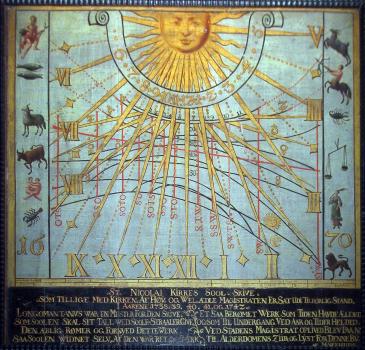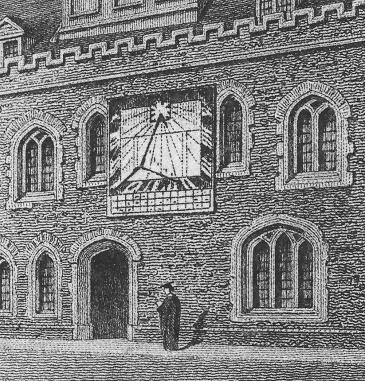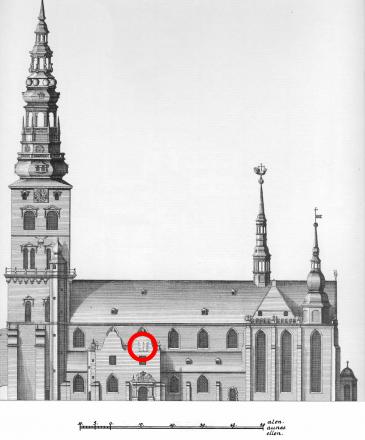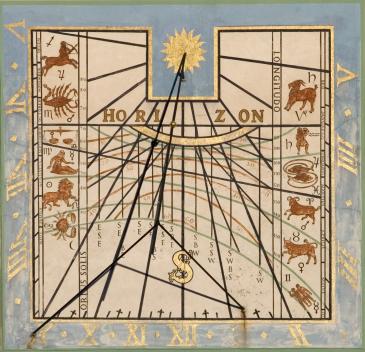The Queens’ sundial, over the library passage in Old Court, has long been thought to be a rare (perhaps unique) example of a sundial with a well developed set of astronomical measuring facilities and astrological symbols. Now we have recently become aware of another sundial which used to exist in Copenhagen, which was remarkably similar in design: so similar that a natural question arises as to whether one influenced the other, or whether they are both descended from some common ancestor.
 Left:
Left:
Sundial of Nicolai Kirke,
Copenhagen.
Right:
Sundial at Queens’ College,
Cambridge.
To discuss the sundials, some terminology needs to be explained. Most sundials are equipped with a gnomon (a rod or straight-edge which is parallel to the earth’s axis) whose shadow indicates time by the sun. Some sundials are equipped also with a nodus (often a ball or a disc) whose shadow indicates a particular point on the dial. The position of the shadow of the nodus can indicate numerous observables other than time, by reference to sets of lines drawn on the dial. On the Queens’ dial, the gnomon is a rod which has a ball nodus mounted on it. An important set of curves on the dial are those of constant declination, where the shadow of the nodus indicates the season of the year. Special cases of these curves are: the winter solstice (the highest curve), the summer solstice (the lowest), and the equinoxes (the straight sloping line in the middle). The intermediate constant-declination curves sub-divide the year into the signs of the zodiac. On any particular date, the shadow of the nodus traces the line of constant declination appropriate to that date.
 We know for certain that the Queens’ sundial was erected in its current position in May–July 1642. We do not know whether the current painted design dates from that time, or whether it was a later ornamentation. The earliest graphical representation of the sundial design is in a print of Old Court by J. & H.S. Storer, apparently published in 1829, where the design is clearly the same as today. In or not long after 1733 the antiquary William Cole noted: “... on ye Wall of ye Chapel and over ye Door wch leads to it is also lately painted a very elegant Sun Dial with all ye signs. This is no small ornamt to ye Court to enliven it.” The phrase “all ye signs” suggests that the current design was in existence in Cole’s time, but his account does not indicate whether the design was a new one then, or whether it was a re-painting of an earlier, perhaps original, design. The similarity of the two dials, and the likely date of the Copenhagen dial discussed below, lends strength to the notion that the present Queens’ design could date as far back as its construction in 1642, as we can at least say that designs of that sort were not unknown at that period.
We know for certain that the Queens’ sundial was erected in its current position in May–July 1642. We do not know whether the current painted design dates from that time, or whether it was a later ornamentation. The earliest graphical representation of the sundial design is in a print of Old Court by J. & H.S. Storer, apparently published in 1829, where the design is clearly the same as today. In or not long after 1733 the antiquary William Cole noted: “... on ye Wall of ye Chapel and over ye Door wch leads to it is also lately painted a very elegant Sun Dial with all ye signs. This is no small ornamt to ye Court to enliven it.” The phrase “all ye signs” suggests that the current design was in existence in Cole’s time, but his account does not indicate whether the design was a new one then, or whether it was a re-painting of an earlier, perhaps original, design. The similarity of the two dials, and the likely date of the Copenhagen dial discussed below, lends strength to the notion that the present Queens’ design could date as far back as its construction in 1642, as we can at least say that designs of that sort were not unknown at that period.
 The Copenhagen sundial no longer exists, but a painted scale model of the dial survives in the Copenhagen City Museum. The original was high on a gable of the south porch of the church of St Nicolas (Nicolai Kirke). The date of 1670 visible on the Nicolai dial is not its date of construction, but is believed to refer to the date it was restored by Ole Rømer (1644–1710), the first astronomer to note that light appeared to take time to travel, rather than appearing instantaneously. The original dial design is attributed to Christen Sørensen Longomontanus (1562–1647), (a pupil of Tycho Brahe), who became professor of mathematics in the University of Copenhagen in 1607. The date of construction of the dial is unknown, but the attribution to Longomontanus places it in the period 1607–1647. Given the great age of Longomontanus, and the need for its renewal by 1670, the date was probably earlier in that period rather than later, and thus it probably pre-dates the Queens’ dial. The painted scale model is signed “C.P. GETREUER PINX” (Christian Peter Getreuer, 1710–1780, master painter and royal gilder), and it was probably made around 1742, when the real dial was already at least a century old. The dial, along with most of the church, was destroyed in the Copenhagen fire of 1795, and survives only in the form of the scale model in the museum.
The Copenhagen sundial no longer exists, but a painted scale model of the dial survives in the Copenhagen City Museum. The original was high on a gable of the south porch of the church of St Nicolas (Nicolai Kirke). The date of 1670 visible on the Nicolai dial is not its date of construction, but is believed to refer to the date it was restored by Ole Rømer (1644–1710), the first astronomer to note that light appeared to take time to travel, rather than appearing instantaneously. The original dial design is attributed to Christen Sørensen Longomontanus (1562–1647), (a pupil of Tycho Brahe), who became professor of mathematics in the University of Copenhagen in 1607. The date of construction of the dial is unknown, but the attribution to Longomontanus places it in the period 1607–1647. Given the great age of Longomontanus, and the need for its renewal by 1670, the date was probably earlier in that period rather than later, and thus it probably pre-dates the Queens’ dial. The painted scale model is signed “C.P. GETREUER PINX” (Christian Peter Getreuer, 1710–1780, master painter and royal gilder), and it was probably made around 1742, when the real dial was already at least a century old. The dial, along with most of the church, was destroyed in the Copenhagen fire of 1795, and survives only in the form of the scale model in the museum.
By coincidence, the orientations of the walls on which the Queens’ and the Nicolai dials were painted are almost the same, so the layout of the lines on the face of the dial are similar, apart from the difference in latitude. The points of similarity between the dials are:
- Both dials have a representation of the Sun in His Glory, with alternating straight and wavy sunbeams, at the point where the hour lines converge and where the line of the gnomon meets the dial plane. In the Nicolai dial, a face is drawn on the sun, and the exact point of these intersections is the middle of its nose. In the Nicolai dial, the straight sunbeams are extended to become the hour lines in gold, and the wavy sunbeams become dotted half-hour lines. In the Queens’ dial, the hour lines are simply black lines that stop short of the sun, there are no half-hour lines, and the sunbeams are somewhat vestigial.
- In both dials, the hour lines are marked with roman numerals, with the half-hours marked by lozenges. On the Nicolai dial, the zodiac signs are outside the hour numbers, whereas at Queens’ they are inside.
- Both dials feature lines for the Temporary Hours, or Unequal Hours, dividing daylight into twelve equal parts of length differing according to season, radiating from the winter solstice line (although the Nicolai dial model incorrectly terminates most of them at the previous line of constant declination). The Nicolai dial numbers the temporary hours 1 to 11 above the winter solstice line.
- Both dials feature seven lines of constant declination, (explained above) including the sloping straight one for the equinoxes. On both dials, the equinoctial line has a different colour from the others. On the Nicolai dial, the constant-declination curves have a flared red arrow-tail at the left-hand end, perhaps to convey the direction in which the nodus shadow will travel each day (from left to right).
- On both dials, full pictorial representations of the signs of the zodiac are displayed at the ends of the constant-declination lines. On the Nicolai dial, the signs of the zodiac occur anti-clockwise, and each sign is positioned at the start of the sign’s period (the cusp of entry): at the end of a constant-declination line. On the Queens’ dial, the signs occur clockwise, and each sign is positioned in the centre of the sign’s period, permitting some constant-declination lines to be extended between adjacent signs.
- On both dials, each zodiac period is accompanied by the symbol of that sign’s ruling planet. On the Queens’ dial, the symbol is placed close to its zodiac sign. On the Nicolai dial, the symbols of the ruling planets are distributed amongst the lines of the dial. Some are drawn in the wrong location: on the left-hand side, Mercury ☿ should be lower within Gemini, and Venus ♀ should be in Taurus, not Aries.
- Both dials feature vertical lines giving the compass bearings of the sun, indexed by the shadow of the nodus. the Queens’ dial goes from ESE to SW; the Nicolai dial has one point further in each direction: from EBS to SWBW. This indicates that, in proportion to the width of the dial, the nodus was closer to the dial plane in the Nicolai dial.
- Both dials feature curves giving the altitude of the sun above the horizon, in steps of ten degrees, as indicated by the shadow of the nodus. The Nicolai dial shows curves labelled from 20 to 50 degrees, with an unlabelled curve perhaps for 55 degrees: at the latitude of Copenhagen, the sun’s altitude cannot achieve 60 degrees. The Queens’ dial includes the 10 degree curve, and goes up to 60 degrees.
A feature of the Queens’ dial not appearing on the Nicolai dial is the prominent horizontal line labelled HORIZON, which can be considered to be a member of the set of altitude lines, representing an altitude of zero degrees. It also serves to indicate the correct height for the nodus, whenever it needs to be re-mounted. Other features found only on the Queens’ dial include (a) the table of lengths of daylight, (b) the table of sunrise times, and (c) the month names.
The Nicolai dial has some interesting features of its own. The symbols for the planets seem to have an earlier form than the symbols now commonly used. In particular, the symbol for Jupiter, normally ♃ in modern usage, appears as (a greek capital letter Zeta ‘Ζ’ with a stroke through the base), an abbreviation for Ζεύς (Zeus), the Greek name for Jupiter. The French classical scholar Claude de Saumaise (1588–1653) suggested that all the planetary symbols were derived from contractions in Greek script of the Greek names for the planets.[Plinianæ exercitationes, by Claude de Saumaise, Vol. 2, p. 874] One can see that this
might evolve into ♃ over years of longhand copying. [The Origin of the Male and Female symbols of biology, by William Thomas Stearn, in Taxon, Vol. XI, No. 4, May 1962, pp. 109–113]
On the Nicolai dial, the sign for Cancer is a crayfish, whereas on the Queens’ dial it is a crab. Historically, there are examples of both having been used as representations of the Cancer sign of the zodiac.
On the Nicolai dial, the sun is surrounded by a scroll bearing the hour numbers in arabic numerals. No such scroll exists on the Queens’ dial.
Below the painted model Nicolai dial is drawn a scale ruler, showing that the width of the real dial was 14 quarter (kvarter), or 7 Danish feet of that period (the Queens’ dial is 8 feet wide). This is in agreement with the architectural elevation and scale shown above, where the dial appears to have a width of 3½ alen, or 14 quarter alen. The scale ruler on the model enables one to estimate that the painted model is at roughly one-quarter scale. Below the scale ruler is recorded, in 18th century Danish, a short history and a poem (by Morten Seehuus 1697–1744), which are the sources of most of the information we have about the dial:
St. Nicolai Kirkes Sool-Skive
Som tillige med Kirken af Høy- og Wel-ædle Magistraten er sat udi tilbørlig Stand
i Aarene 1738, 39, 40, 41, og 1742.
Longomontanus war en Mester for den Skive,
Som Solen skal sit Tall wed Soole-Straaler give.
Den ærlig Rømer og fornyed dette Werk,
Saa Soolen widnet selv, at den war ret og stærk.
Et saa berømet Werk, som Tiden havde ælded,
Og som til Undergang ved Aar og Tider helded,
Ved Stadens Magistrat oplived blev paany
Til Alderdomens Ziir og Lyst for denne By.
Af M. Seehuus.
which can be roughly translated as:
St Nicholas Church’s Sundial
Which together with the Church was put into proper Condition by the noble and gentle Council
in the years 1738, 39, 40, 41, and 1742.
Longomontanus was Master of this Dial,
To which the sun shall give its tally with sun-beams.
The honest Rømer, too, renewed this work,
So that the sun itself witnessed it was right and strong.
A work so famous, which Time has aged,
And which by Time and Tide declined towards ruin,
By the City Council became enlivened anew
Into antiquity’s adornment and delight for this town.
By M. Seehuus.
The similarity between the Nicolai and Queens’ dials was first noted by the Danish astronomer Axel V. Nielsen (1902–1970) in an article Soluret — den sollyse dags tidsmåler, pp. 16–52 in the 1953 yearbook of Den Gamle By, Købstadsmuseet. Nielsen was the author of a book on Ole Rømer and worked at the Ole Rømer museum at Aarhus.
No trace of any connection between Queens’ College and Copenhagen has yet been found that might explain the existence of two such similar sundials of similar ages.
Credits
I am grateful for assistance in compiling this article from Frank King (Cambridge) and Claus Jensen (Denmark). The photo of the Nicolai dial is reproduced by permission of the Copenhagen City Museum. This article first appeared in The Record, 2008, pp. 16–18.
Further reading
1923: Fra Københavns Bymuseum, by Christian Axel Jensen, in Illustreret Tidende, vol. 64, no. 29, 1923 April 15, pp. 597–9, sundial at p. 599. (OCLC 464264781)
1945–58: Sankt Nicolai Kirke, by Jan Steenberg (1901–71), in Danmarks Kirker, I, bind 1, pp. 459–621, sundial at p. 549. (OCLC 21407081)
1953: Soluret — den Sollyse Dags Tidsmåler, by Axel Vilfrid Nielsen, in »Den Gamle By« Årbog 1953, Købstadmuseet, pp. 16–52, at p. 50. (ISSN 0105-9254)
Further reading on the origin of planetary symbols
1629: Plinianæ exercitationes in Caij Iulij Solini Polyhistora, by Claude de Saumaise, Vol. 2, pp. 1237–8. (OCLC 57293719)
1689: another edition, Vol. 2, p. 874. (OCLC 57293701)
1679: Animadversiones in Manilium, et Scaligeri Notas, by Pierre Daniel Huet, pp. 80, 83, in M. Manilii Astronomicon : Interpretatione et Notis, ed. Michel du Fay (Fayus). (OCLC 59214885)
1688: Glossarium ad scriptores mediæ & infimæ graecitatis, by Charles du Fresne, sieur du Cange, Vol. 2, Notæ pp. 2, 5. (OCLC 265460194)
1791: Beyträge zur Geschichte der Erfindungen, by Johann Beckmann, Vol. 3, Part 3, Article 2, pp. 372–4. (OCLC 493868759)
1797: translated into English as: A history of inventions and discoveries, tr. William Johnston, Vol. 3, pp. 67–9. (OCLC 499308821)
1829: Palaeographia Critica, by Ulrich Friedrich Kopp, Part 3, §287, p. 342. (OCLC 266077273)
1920: The Origin of the Planetary Symbols, by Annie Scott Dill Maunder and Edward Walter Maunder, in Journal of the British Astronomical Association, Vol. 30, No. 7, 1920 April, pp. 219–223. (ISSN 0007-0297) [precursor of the 1934 article below]
1934: The Origin of the Symbols of the Planets, by Annie Scott Dill Maunder, in The Observatory, Vol. 57, No. 723, 1934 August, pp. 238–247. (ISSN 0029-7704) [Does not take account of earlier work on Greek contractions. Used as a single unverified source by Wikipedia]
1937: The Origins of the Planetary Symbols for the Metals, by James Riddick Partington, in Ambix No. 1, pp. 61–4. (ISSN 0002-6980)
1942: Oorsprong, beteekenis en toepassing van de in de botanie gebruikelijke teekens ter aanduiding van het geslacht en den levensduur, by H. W. Renkema [?? Herman Wiemer Renkema 1889–1959 ??], in Gedenboek J. Valckenier Suringar, pp. 96–108. (OCLC 63370418)
1962: The Origin of the Male and Female symbols of biology, by William Thomas Stearn, in Taxon, Vol. XI, No. 4, May 1962, pp. 109–113. (ISSN 0040-0262)
